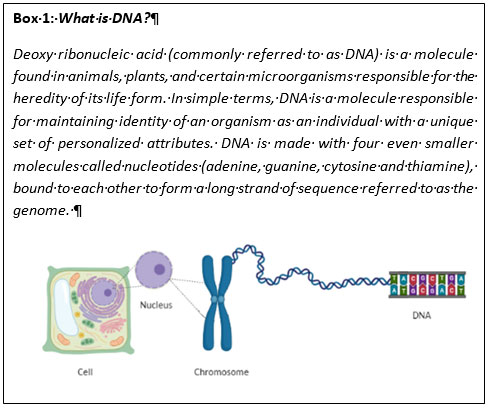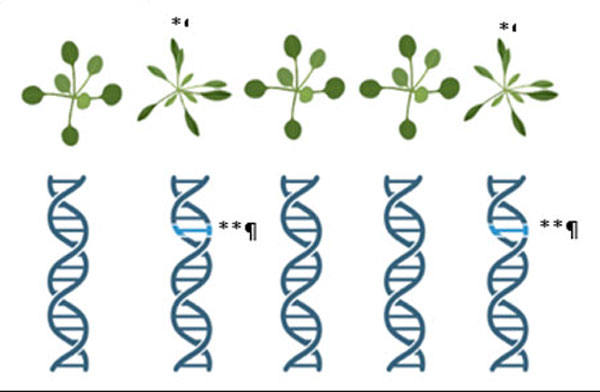Dimanthi Jayatilake, PhD
Senior Lecturer, Department of Agricultural Biology, Faculty of Agriculture,
University of Peradeniya, Peradeniya
Since the transition from a nomadic hunter-gatherer lifestyle to a farming-oriented settlement, humans have constantly looked for ways to improve the returns from the seeds they sow. From the unintentional selections done during crop domestication to strategic steps taken during the green revolution, the plant breeders have changed, mixed and matched to improve the crops, with the intention of feeding the growing population. When Swiss researcher Friedrich Miescher first discovered the DNA molecule in 1869, he himself would have not imagined that it would bring the next revolution in agriculture. Nearly 150 years since, the long journey of breeding crops for better yields, resilience to biotic and abiotic stresses, and improved quality attributes, have come to a conjuncture, where we seek answers within the DNA, to breed crops with the best genetic potential to improve the productivity in our croplands.
Stepping to the DNA era of plant breeding
 Earliest plant breeders depended on the visual observations of the crop morphology and physiology to make selection-decisions to improve crops. However, the selections were not always accurate, as the physical appearance (morphology) and physiology of the crop plant is heavily influenced by the environment. With the realization of the environmental impact and availability of technology, the crop breeders in time moved to make the selection decisions based on biochemicals, and later based on the information found in the DNA (Box 1).
Earliest plant breeders depended on the visual observations of the crop morphology and physiology to make selection-decisions to improve crops. However, the selections were not always accurate, as the physical appearance (morphology) and physiology of the crop plant is heavily influenced by the environment. With the realization of the environmental impact and availability of technology, the crop breeders in time moved to make the selection decisions based on biochemicals, and later based on the information found in the DNA (Box 1).
This marks an important milestone in the field of plant breeding, where the plant breeders supplemented the classical plant breeding approach based on visual selections, with information written on the genome. Target sites on the genome used for the purpose are known as DNA markers. DNA markers are artificially amplified from a selected region on the genome using a method known as polymerase chain reaction (PCR). By comparing the information generated from the PCR from different plants/varieties, breeders can identify variations in the DNA region (Box 2).

Some DNA variations are positively linked to the desired character states and others are negatively linked. For a plant breeder knowing these details is important to make better-informed and accurate decisions during the critical stages of selection. This approach is commonly referred to as marker-assisted selection and it supplements the conventional plant breeding work by improving the breeding efficiency in terms of precision, cost, and time. Such diagnostic DNA markers are currently available for many crop species, covering many important plant characters such as yield and quality attributes, pest and disease resistance, and tolerance to abiotic stresses (salinity, drought, submergence, etc.) to name a few. With the technologies such as next generation sequencing and availability of genome assemblies of many crop species, the potential to develop efficient DNA markers is at its peak.
DNA markers are also important to characterize the diversity found in our germplasm. Sometimes morphology may appear similar as a response to the environment and/or as an adaptation to survival. The finer differences present in the DNA molecule shall allow the scientists to assess the genetic diversity (diversity of heritable traits) and report the uniqueness. This is often done using DNA markers designed based on largely conserved regions, flanking highly evolving regions in the DNA found in cellular organelles such as chloroplasts, mitochondria, and even in the nucleus – a concept commonly known as DNA barcoding (Figure 1).

Figure 1: DNA Barcoding
DNA barcoding allows rapid and precise identification of species. It is a PCR-based approach, where guided by DNA markers, the target DNA of a particular individual is amplified and then sequenced (to determine the order of nucleotides) to reveal one’s uniqueness compared to others. This technique allows the determining of evolutionary relationships between plant species and reveals the relatedness of crop wild relatives. The information is very useful in crop improvement programs for the introgression of genomic regions known to be associated with desired characteristics (such as resistance and tolerance to biotic and abiotic factors, and quality attributes) from their wild progenitors or relatives to modern-day crops. Further, knowledge of this relatedness is also important to explore alternatives to prevent exploitation of one species.
In the current day and age, the use of DNA technology has developed much more than just looking at the DNA level variations that are naturally occurring. We have stepped into an era where we create variations to achieve targeted improvements by means of altering the genome within the organism or by introducing DNA “alien” to the organism. Does the words ‘create’ and ‘alien’ sound sinister? May be, but only until one realizes the fact that it’s nothing that we have not done in our progression as plant breeders throughout the age-old approaches. In the past we have meddled with the natural state of the genome of individual crop plants through selection and crossing with other individuals with desired characteristics, yet there it sounds less alarming as the process is not seen or made to see as a man-made alternation of the crop genome. The approach takes the limelight when dealt at a molecular level, especially when performed going past the defined species barriers. Despite the skepticism, science has advanced in areas such as gene manipulation to engineer genetically modified organisms within a vigorous and highly regulated work frame. Since its adoption as a technique in the mid-1990s, many genetically engineered plants have come through the pipelines to serve the greater cause of feeding the growing population under limited land resources and as an environmentally kinder alternative. To create genetically modified (GM) plants, a desired gene from the same species or a different species is transferred to the target organism aiming for improvement of desirability (Box 4).
 |
Some of the recently released genetically modified (GM) organisms that have broken the barriers/ taboos to reach the consumers are soybean with glyphosate (Roundup®) herbicide tolerance, corn with resistance to the European corn borer (a pest), canola with altered fatty acid composition, plums with resistance to plum pox virus, shelf-life enhanced tomato and vitamin A enriched golden rice. Yet the approval for commercial use is subjected to policies governed in respective countries. The split consumer perspective on the matter is due to fears of potential adverse effects of GM products on health and the environment. With the advancement of gene-editing technologies such as CRISPER-Cas the potential to improve widens. Currently the GM products are deregulated for market release only in some countries. Due to this matter, the true potential of the technique is yet to be realized. Though GM foods are not the all-in-one cure for alleviating hunger, it is a huge leap forward if we accept the mere possibility that GM-devil may not be as black as painted and give it a chance.
Could DNA technologies hold prospects for the Sri Lankan agricultural sector?
With a booming population, feeding a nation with good quality produce in ample stocks exerts constant pressure on agriculturists. With urbanization and the need to protect and conserve the remaining wilderness reserves and protected forests, expansion of agricultural lands is next to impossible. Therefore, the need to increase the productivity of existing agricultural land is a national priority. However, due to the rising cost of agro-chemicals, the growing concern over the damage to the environment and potential health hazards that looms in the shadow due to misusing of these chemicals in agriculture, pre-harvest losses due to biotic and abiotic stresses, and postharvest losses due to mishandling of products has led to the realization of the importance of improving the genetic potential of crops to minimize losses more than ever before. Use of molecular breeding and biotechnology have been recognized in national breeding programs as an important step to accelerate the achievement of breeding targets in crop species. However, at the grass-root level, the resources, and the framework to conduct research related to exploring the greater genetic diversity seen in crop species in Sri Lanka are limited. This imposes a greater challenge for the scientists to evaluate genetic diversity and develop needed molecular tools for the purpose. However, currently for the major crops, marker-assisted selection is operating at a smaller scale, yet its far behind than where it needs to be. Exploring genomic resources beyond the point of using DNA markers to improve crops is limited in the current framework, where genetic engineering research and commercial use of GM plants or produce is restricted. With the current economic crisis, the need of exploring the genetic potential of crop plants is important more than ever to ensure better production, and reduce pre and postharvest losses, especially given the short supply of agrochemicals and the high cost of production. Further, due to the climate adversities each year we lose a considerable harvest and through modern technology we could aim for engineering resilient crop plants as a solution to a burning issue. Therefore, investments in research and development cannot get the short end of the stick, rather it needs to be a priority in the national strategy for food security. In addition, training the researchers and breeders in the latest DNA technologies, creating awareness among public and policy makers to separate science from pseudoscience, and taking decisions pertaining to evidence-based scientific communications is a priority to set the path for Sri Lanka as a nation to head towards the best use of the unique crop genomes the country is blessed with. The answers we seek for the most pressing problems in agricultural productivity are hidden in the DNA of the crop itself. It's time now - not tomorrow, and rather than looking far, it's time to look within the crop genomes to achieve prosperity in food security.
Image Credit
All images were created in BioRender.com for educational purposes.
References
Phillips, T. (2008) Genetically modified organisms (GMOs): Transgenic crops and recombinant DNA technology. Nature Education 1(1):213
Schouten HJ, Krens FA, Jacobsen E. Cisgenic plants are similar to traditionally bred plants: international regulations for genetically modified organisms should be altered to exempt cisgenesis. EMBO Rep. 2006 Aug;7(8):750-3. doi: 10.1038/sj.embor.7400769. PMID: 16880817; PMCID: PMC1525145.
Leave Comments